Fulham’s Man-Oriented Approach Against Manchester City
Man-orientation is relatively common when pressing, but not in consolidated defensive play. However, it can appear via a mix of man-orientation and zonal marking, depending on the location of the ball. For example, a defensive backline may become man-oriented against an opposition front line when the ball is being progressed forward, with the aim of preventing simple reception.
Quite commonly, a defender may become man-oriented on an attacker when they appear in their designated zone (for example, an attacker may drift into the half-space which encourages a wide centre-back in a back three to apply pressure), which manifests the balance between zonal and man-orientation. Zonal defensive play during consolidated defence is more common, especially in the Premier League, because it is more effective at blocking crucial space. Man-orientation relies heavily on winning individual duels to prevent the opposition from simple reception with time and space, and therefore the approach carries a great element of risk.
Fulham’s man-oriented approach against league leaders Manchester City was extremely interesting, and also rare. This was largely because City’s rotations in attack have been more fluid this season in comparison with previous seasons, increasing the unpredictability of their attacks. It also makes man-orientation more difficult to sustain because the fluid rotations and interchanges can pull defenders out of position, opening up dangerous space.
Their strategy was bold due to the quality of opposition they were up against. Arguably the greatest risk that comes with a man-oriented approach is the loss of an individual duel because it can open up vital space for an opponent. For example, a lost duel between the lines allows the opponent to drive at the heart of your defence, whilst other defenders are committed to marking their designated men which can essentially lead to a free man being created.
Despite these risks and potential drawbacks, Fulham’s performance highlighted how it can be an effective strategy if the rationale is to prevent ball progression through specific players or a specific area of the pitch. The strategy worked well despite the eventual scoreline. This article will break down the aim of the approach and how successful it was, whilst also showcasing a potential open play solution for Manchester City.
Firstly, the rationale behind the aggressive strategy seemed to be to block City from progressing the ball centrally, especially through double-pivot Rodri and Bernardo Silva. This was evident in the pressing phase, but also in consolidated defence, which was surprising. Fulham opted to maintain their spare man in the defensive line through either Tosin Adarabioyo or Joachim Andersen, depending on the position of other attackers. This was predominantly Tosin, as Andersen kept close tabs with Gabriel Jesus, whilst left-sided defended Ola Aina pressured Ferran Torres. Harrison Reed dropped extremely deep to mark Sergio Aguero, which was an interesting strategy because it created a vast amount of space between Fulham’s midfielders.
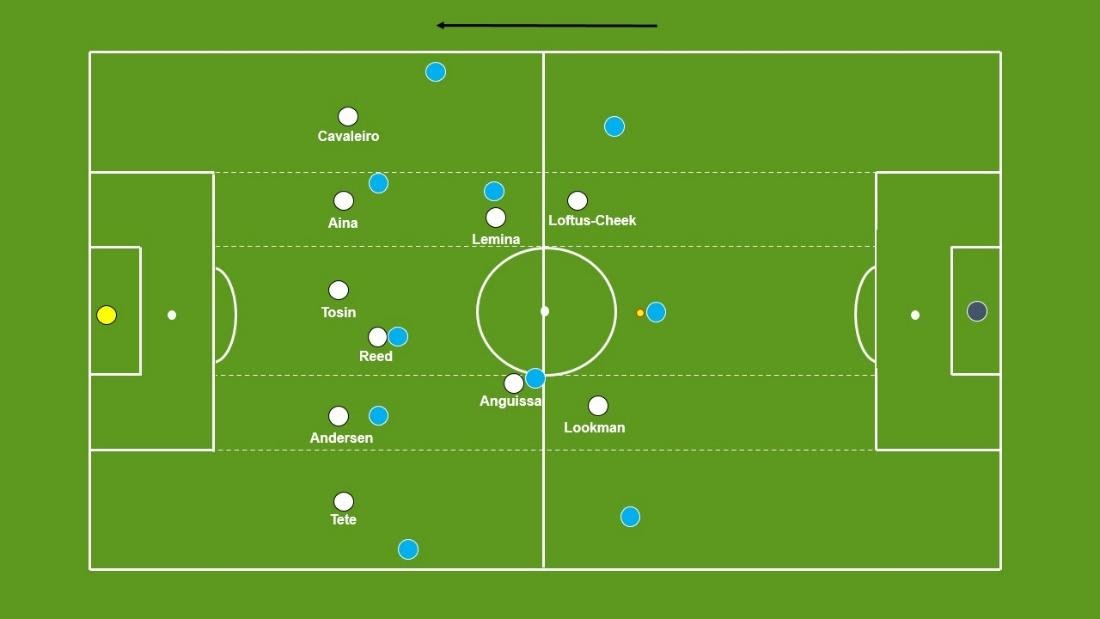
Kenny Tete marked City left-back Benjamin Mendy, whilst winger Ivan Cavaleiro dropped extremely deep to create what was a back five or six at times, to mark the dangerous Joao Cancelo. In midfield, Anguissa and Lemina marked the double pivot of Rodri and Bernardo Silva respectively, which was a fundamental part of the overall plan, whilst forwards Ruben Loftus-Cheek and Ademola Lookman were tasked with applying pressure onto the wide centre-backs when they received possession and threatened to carry the ball forward.
The man-oriented approach was largely effective, as City were often stuck when they had possession around the halfway line. Fulham largely prevented central progression throughout which seemed to be the aim of the setup. They were also aggressive in their duels and prevented City’s attackers from simple reception, thereby preventing them from turning and attacking the goal face on.
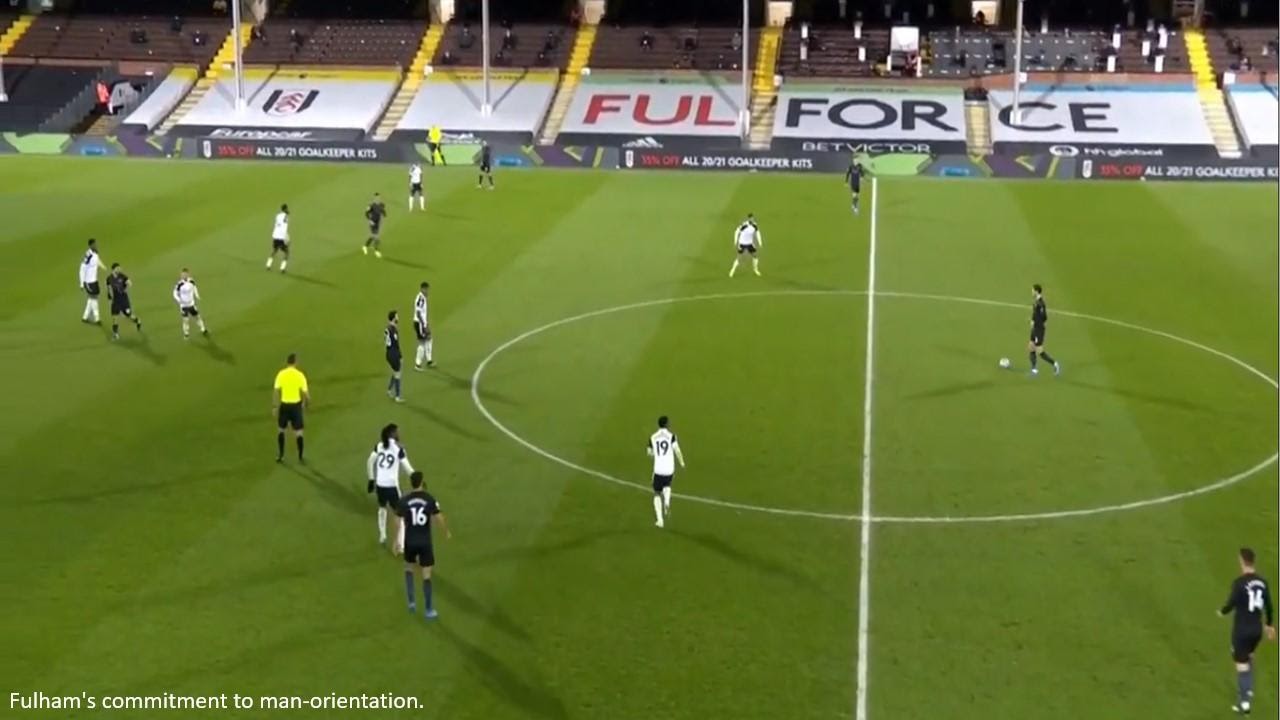
As aforementioned, it’s vital to be aggressive and proactive when entering duels in a man-oriented manner. From a defensive perspective, you must prevent the attacker from turning at all costs and therefore you must be aggressive and force the opponent backwards. If the attacker beats the defender, space will open and this will facilitate the creation of a free man in the final third.
Fulham were aggressive in their duels when the ball was progressed into the feet of City’s attackers, especially in the half-spaces. This was perhaps one of the key reasons behind Scott Parker’s plan to keep the spare man in the defensive line; to allow the wide defenders to be even more aggressive in the half-spaces due to the extra protection behind.

Fulham were more than happy to concede space between the lines, given their heavy man-oriented approach out of possession. The positions that the defenders take up in a man-oriented approach is completely dependent on the positioning of the offensive team, which essentially gives them control regarding space creation.
Scott Parker’s midfield three naturally became stretched, both vertically and horizontally, as their deepest midfielder Harrison Reed stayed close to Sergio Aguero, who often operated close to the backline. This created space between him and Fulham’s more advanced midfielders, Lemina and Anguissa, who pushed high onto City’s pivot. Therefore, Fulham conceded a vast amount of space between the lines, which became even greater when the double pivot of City dropped deeper in possession.
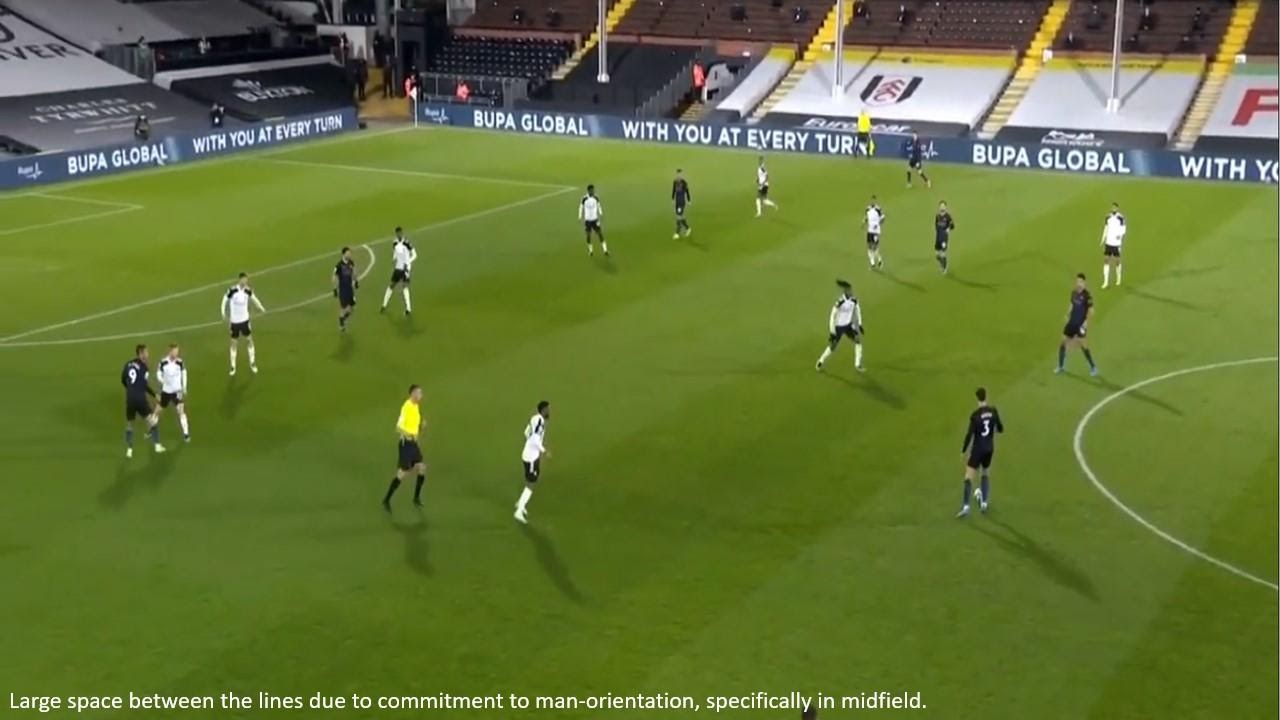
Fulham were comfortable in conceding space between the lines, which is typically space that the defensive team would try to protect and minimise, because the man-oriented approach focuses on tracking men when they move into these zones, rather than immediate space protection, which decreases the danger of the space from a defensive perspective.
Essentially, there is a greater emphasis on preventing simple reception rather than space protection. A hypothetical example of the action is illustrated below, using the same image because it manifests how the man-oriented approach created the space between the lines exceptionally well.
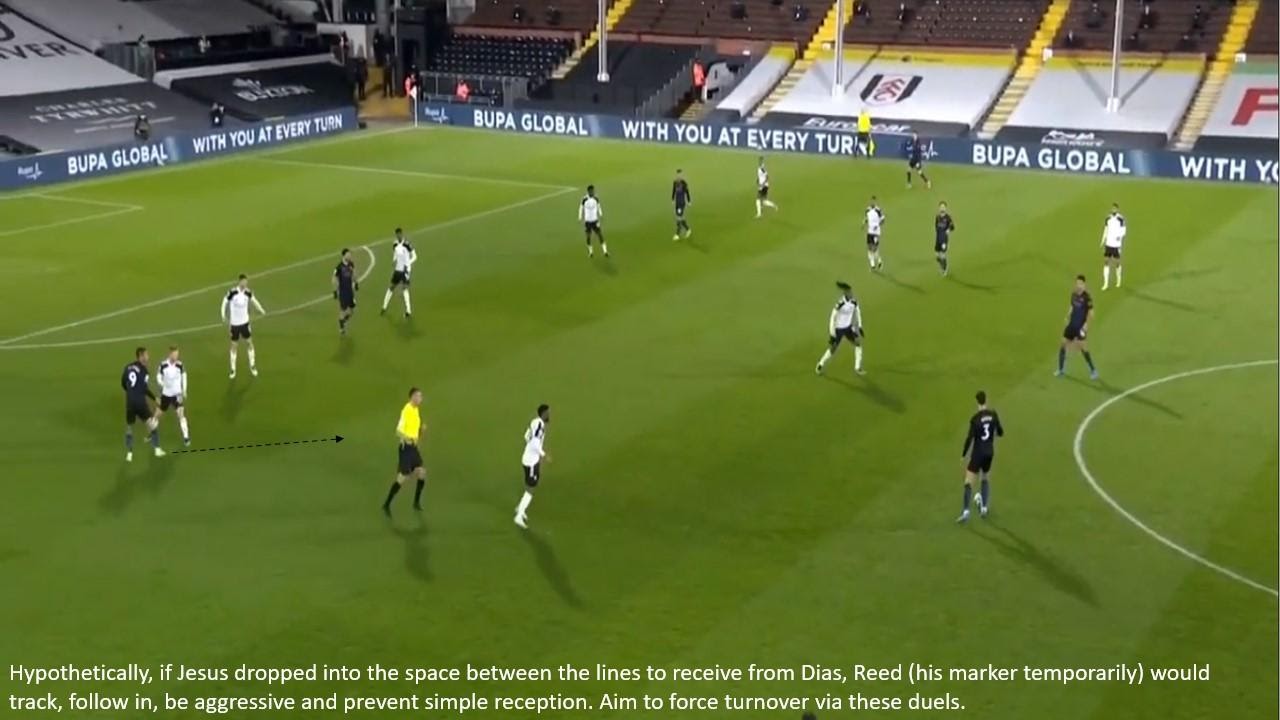
Fulham also evidently allowed City’s central defender, Ruben Dias, deep ball possession without pressure. This was largely because the front two, Ruben Loftus-Cheek and Ademola Lookman, focused on preventing the wide centre-backs from moving forward and progressing the ball, which therefore left Dias as the spare man due to Parker’s decision to include the spare man in the backline. Fulham’s defensive shape was largely more effective when the threat of John Stones was nullified by Loftus-Cheek.
The value of the wide centre-back has been illustrated in recent times; they have immediate access to the half-spaces during progression due to their positioning and they can help create overloads in the final third when they advance. This was evident at times during the first half when Stones advanced forward without being tracked. He often provided City with a spare man in the final third which disrupted Fulham’s man-orientation.

It was also a problem for Fulham when City had deep possession. When Loftus-Cheek committed to the centre, perhaps dependent on the position of the ball, Stones was left completely free due to the commitment to man-orientation all over the field. Therefore, this also handed City the opportunity to circulate the ball quickly to the spare man in order to progress the ball into Fulham’s half.
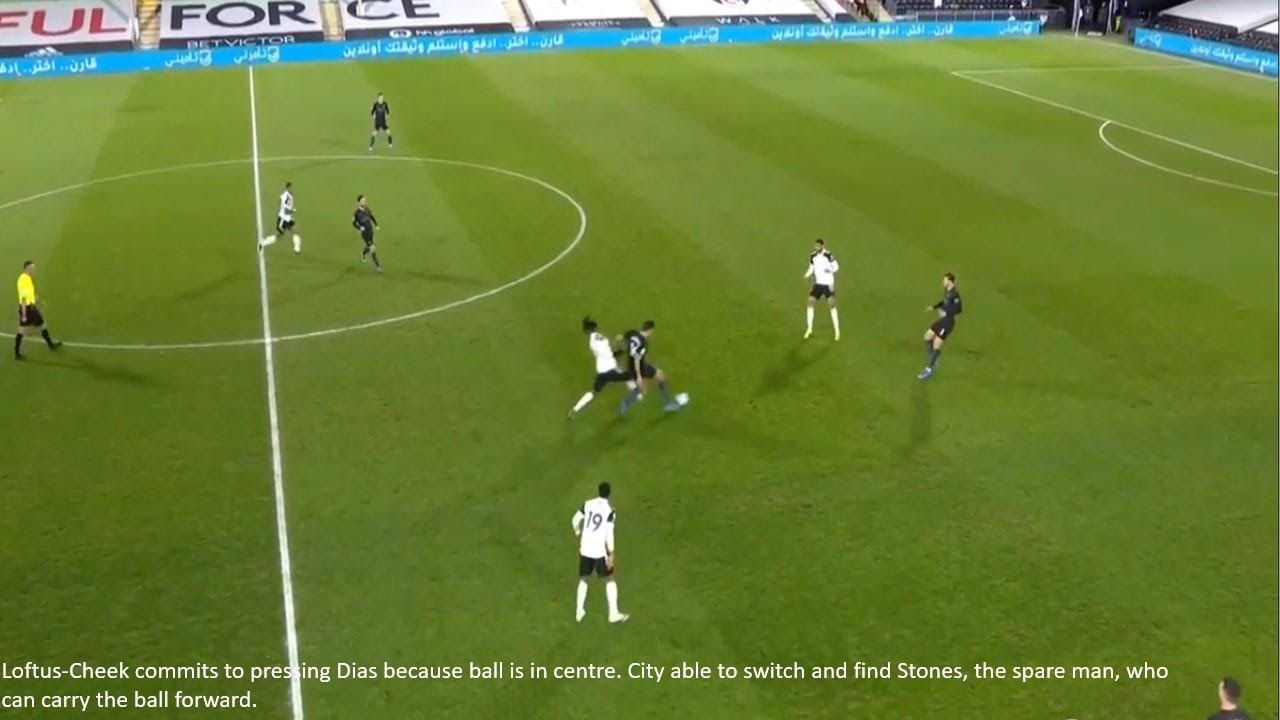
In addition to these reasons as to why Dias was often unpressured in deep areas, Fulham were confident that they could apply pressure centrally onto any player that Dias progressed the ball to. Their man-orientation in midfield naturally provided good coverage of central areas and therefore they were satisfied with Dias having possession knowing that they would pressure the receiver immediately. This often led to stagnant, deep possession around the halfway line for City, so Fulham remained comfortable in conceding possession to the deepest central player.
However, problems began to arise when the double pivot of Manchester City began to split wider, as they seemingly recognised the space Dias was in. Splitting wider essentially dragged the opposition midfielders with them, therefore increasing the space between them causing for less effective central coverage of the pitch, which in turn increased the amount of space Dias had in possession. This allowed him to drive forward into Fulham’s half without pressure. This highlights how the players can have a spontaneous and proactive impact during the match without tactical instruction.
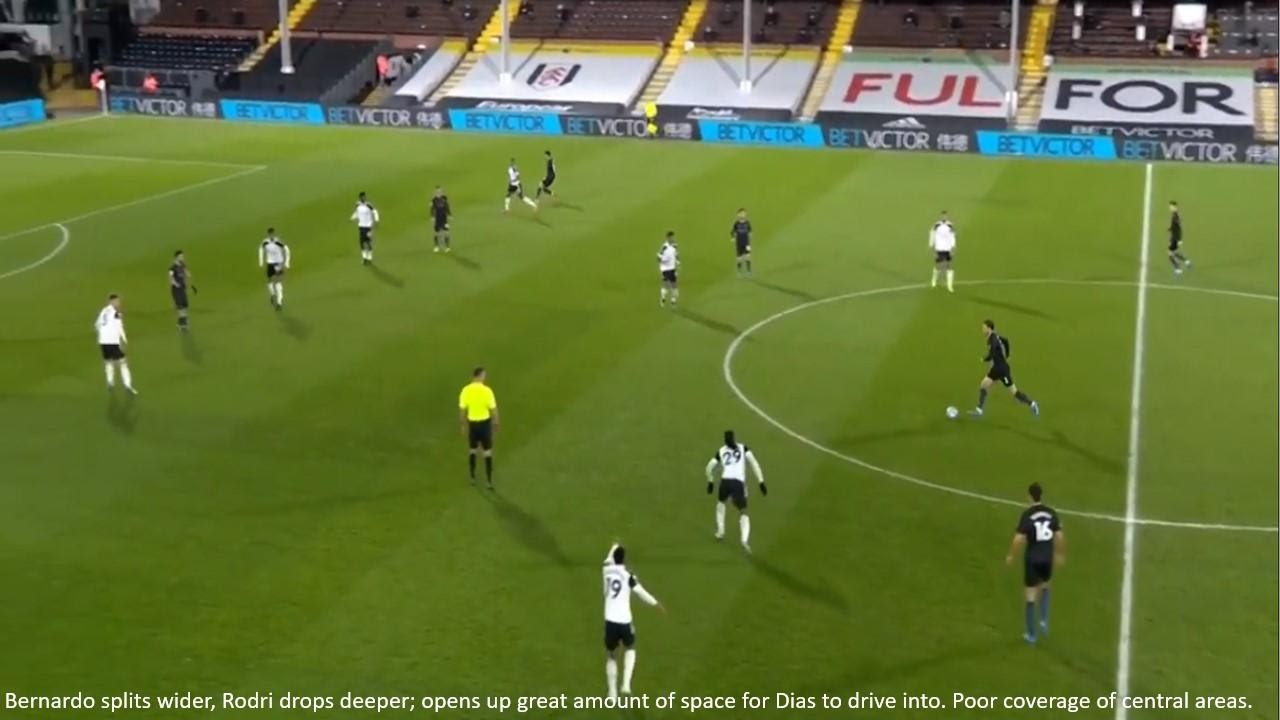
However, Fulham’s solution to this involved the passing of responsibility between Anguissa and Lookman, which manifested a spontaneous alternation according to the problems occurring in the pitch. Lookman’s starting position was narrow in preparation to press the wide centre back, Aymeric Laporte, however, this narrow positioning essentially meant his starting position was in proximity with Rodri.
To solve the problem and reduce the amount of time and space Dias had in possession, which was exacerbated when the double pivot peeled wider, Anguisaa passed the responsibility of marking Rodri onto Lookman, who dropped into a narrower position, whilst the midfielder engaged Dias to prevent him from carrying the ball on for Fulham’s half without pressure. This allowed for greater zonal coverage of central areas which ultimately led to a good balance of zonal and man-orientation in this case.
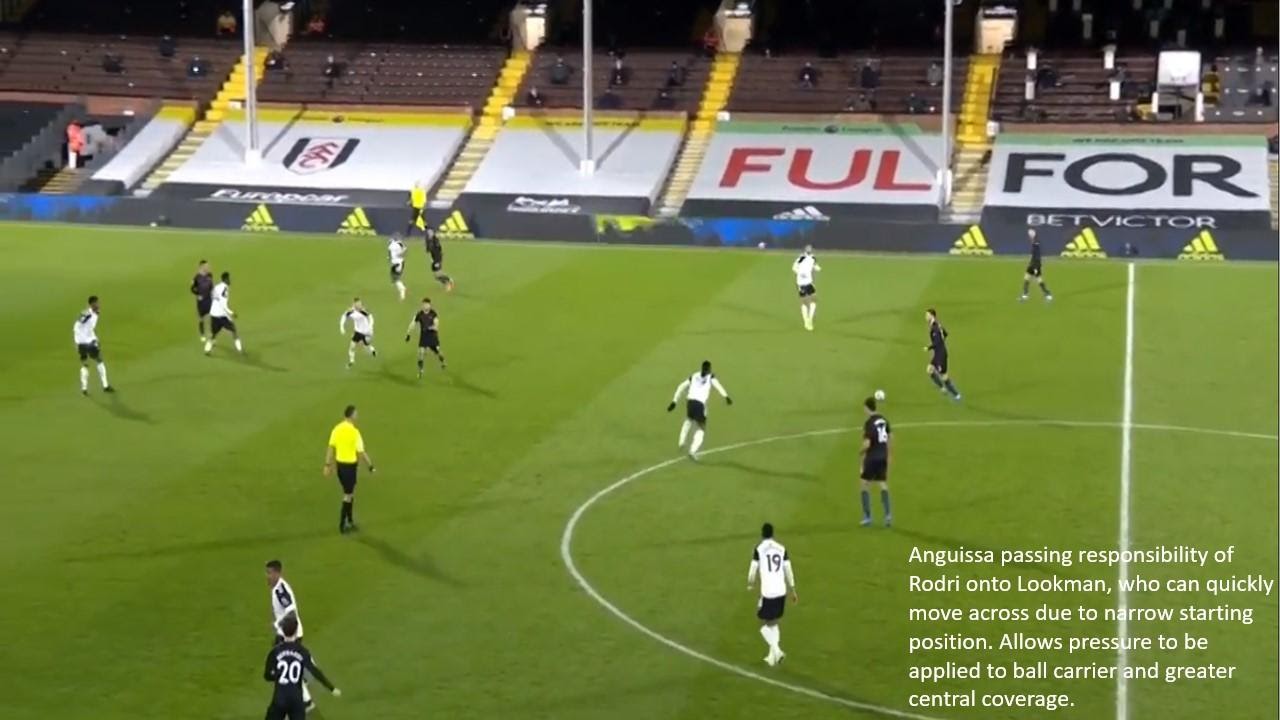
Another intriguing aspect of the approach, which is aforementioned, was Harrison Reed’s responsibility to mark Sergio Aguero. This often left Reed in an extremely deep position, almost on the backline, which ultimately manifested itself in a Fulham back six. The decision to go with the spare man (typically Tosin, although interchangeable dependent on ball position and opposition players) in the defensive line seemed to be to ensure that Fulham maintained an overload across the backline.
This essentially helped Fulham react to switches by having the horizontal coverage to apply pressure to the receiver on the opposite flank. It also allowed greater aggression in the half-spaces when wide centre-backs stepped out to force a turnover because there was greater coverage of dangerous space behind. Although this worked well, a potential alternative may have been to have Reed as the spare man and allow Tosin to mark Aguero.

This would have improved Fulham’s zonal coverage between the lines and may have somewhat prevented attackers dropping deep to receive due to Reed screening the defensive line. This strategy would have perhaps been more risky and aggressive considering less protection in the defensive line and therefore greater pressure on defenders when engaging in a duel, however, this hopefully would have prevented the number of duels that occurred due to greater protection of central space.
A potential solution for Manchester City would have involved positional rotation to disrupt and manipulate the man-orientation across the defensive line. Fulham’s defensive line remained relatively high and flat, which can be susceptible to a run in behind when the attacker has the momentum. This problem is exacerbated when the defensive team fail to apply pressure onto the ball carrier (Liverpool for Real Madrid’s opening goal this week) because it grants the opposition time and space to initiate the movement and pass. This was evident with Ruben Dias, as mentioned throughout.
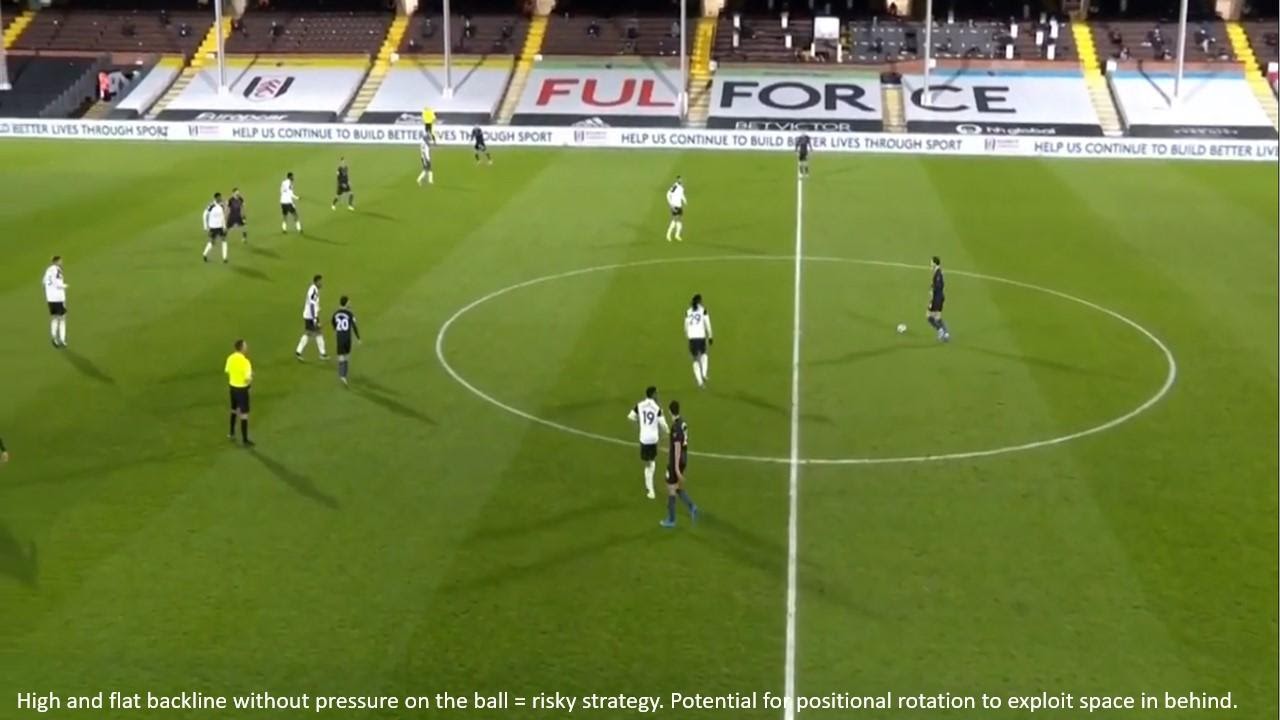
Surprisingly, City hardly attempted to exploit the space in behind despite the obvious space there. On a few occasions they did, the pass was either overly weighted or simply inaccurate. Therefore, greater precision and weight on the pass would be required to maximise the potential of this solution. An example of positional rotation which may have been able to exploit the space in behind Fulham’s defensive backline and disrupt and evade their man-orientation is illustrated in the sequence of images below.
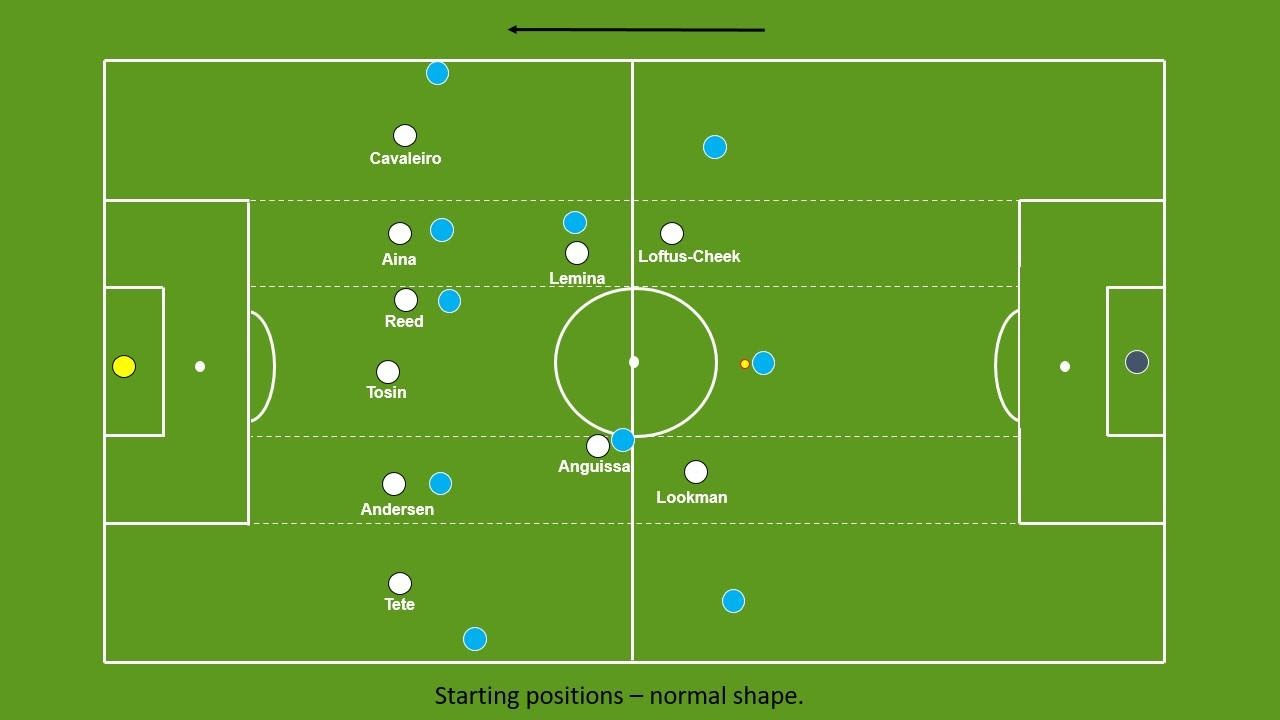
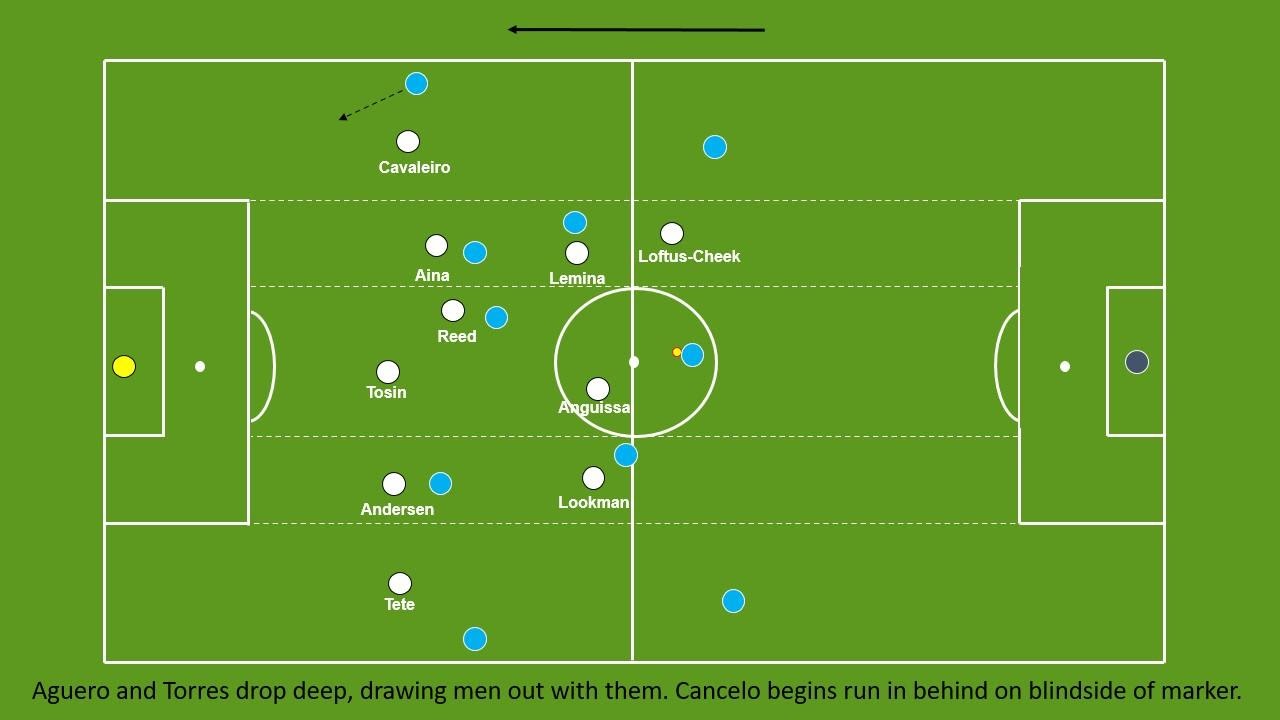

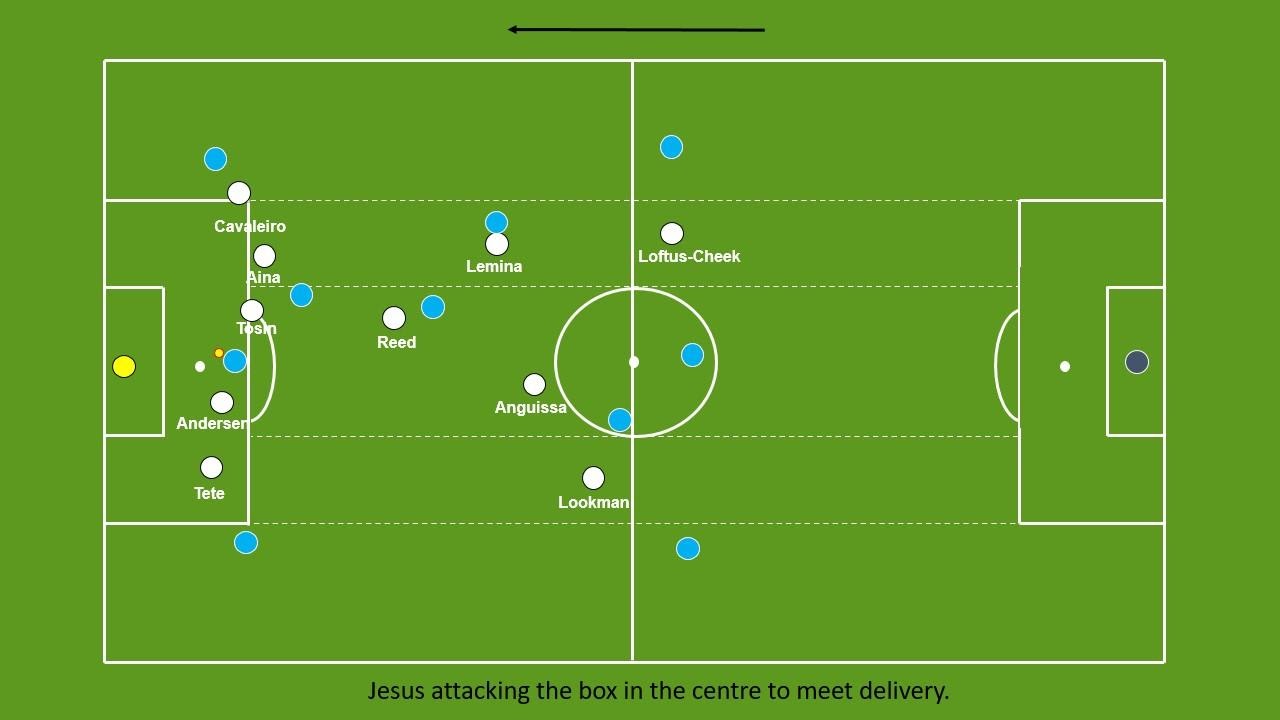
This essentially would have allowed City to bypass the man-orientation, especially in midfield and attack, by finding and attacking the space in behind the defensive line rather than progressing the ball into the feet of the forwards dropping deep, only to be pressured aggressively upon reception which can force many turnovers.
In summation, Fulham’s man-oriented approach was successful in the first half, often limiting Manchester City’s central options, forcing them into stagnant possession around the halfway line. They were aggressive in their duels when City did progress the ball into their attackers and often won their duels, creating turnovers. The first half performance highlighted the benefit that a man-oriented approach can have on preventing simple reception, whilst also showing some of the risks that the strategy contains.
Ultimately, the performance was let down by costly individual mistakes which saw Fulham fall to 0-3 defeat. The goals came from a set-piece, a penalty, and an individual error by Joachim Andersen which gifted Gabriel Jesus the vital second goal. Fulham’s individual errors which ultimately covered up what was a brave and aggressive performance highlights the fine line that should be considered when defining and evaluating a manager’s tactics, and how successful they were.
In this case, the strategy worked extremely well as Fulham were able to nullify City to a certain extent, which has proved to be an exceptionally difficult task. However, individual mistakes took over in the second half, which likely dealt a psychological blow to the team, which decreased their chances of maintaining performance levels and ultimately collecting a good result. Therefore, it is important to remember the external factors which are essentially out of the coach’s control when evaluating the strategy and tactical nature of a team’s performance.
However, overall, this performance perhaps could be a platform to build on when playing Manchester City. Despite the obvious risks, it prevented City from progressing the ball centrally in the build-up, whilst also providing them a conundrum in possession around the halfway line. Therefore, it will be interesting to see if the heavy man-oriented approach will be utilised again in an attempt to defend the champions-elect.
By: Ollie Himsworth
